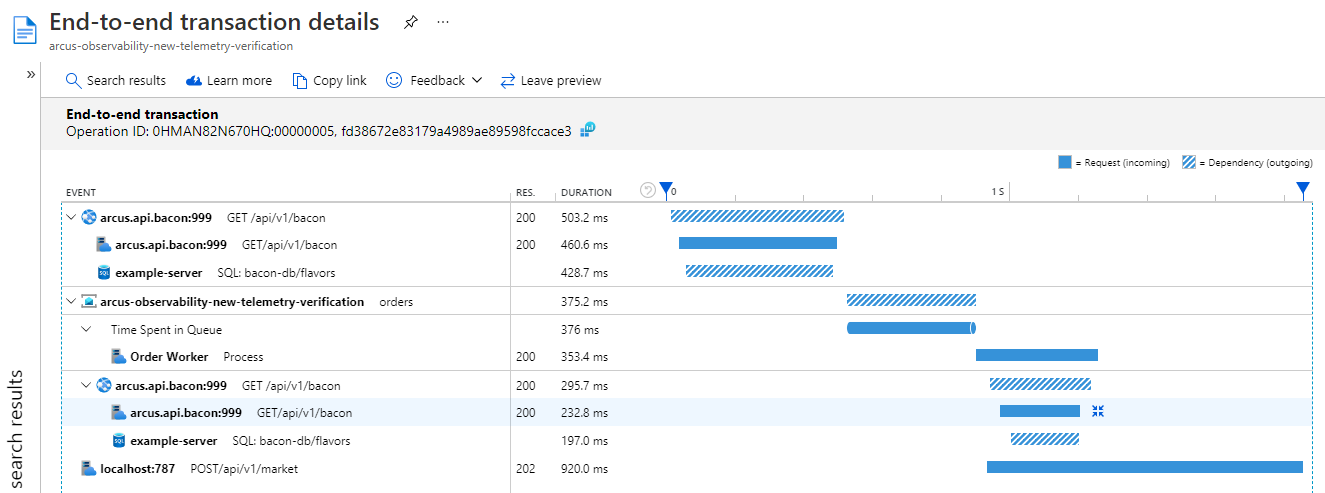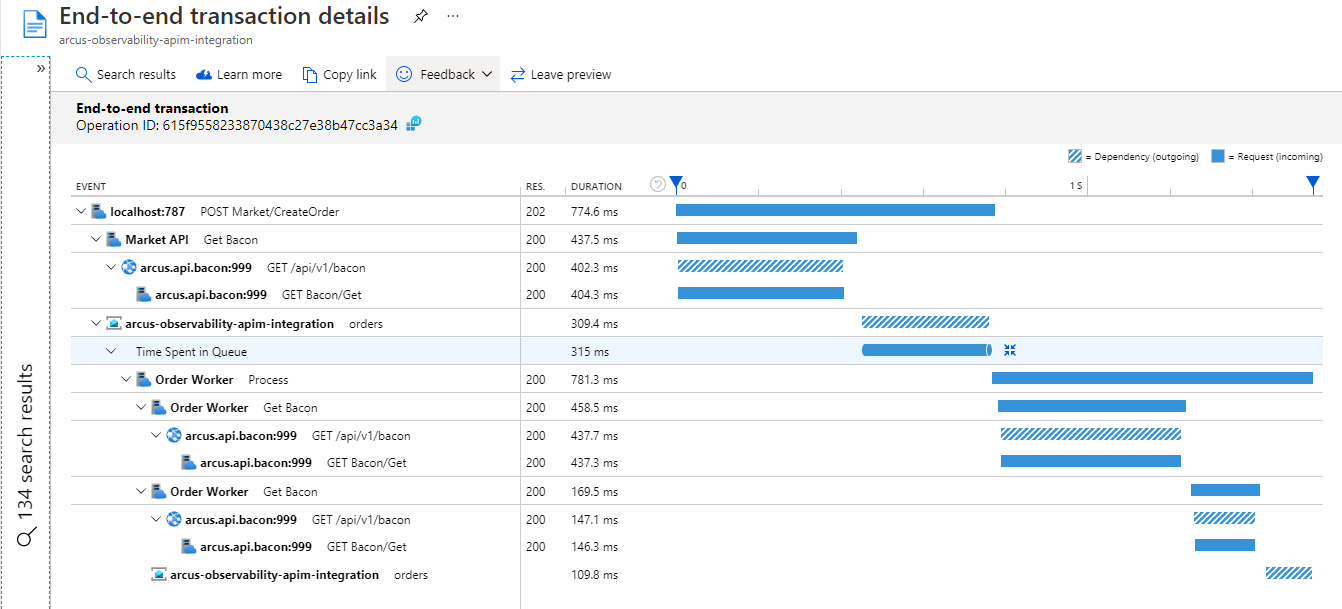POC to have end-to-end correlation stitching operations across services together in the Azure Application Insights Application Map.
Provide end-to-end correlation stitching operations across services together in the Azure Application Insights Application Map.
When creating an order, the following flow occurs:
- Correlate across services in the Azure Application Insights Application Map
- Support for HTTP dependencies
- Support for Service Bus dependencies
- Correlate multiple interactions in the same operation & component, in a tree-manner
- Ensure the measured dependencies are comparable to the native Azure Application Insights telemetry
As per the guidance:
Application Insights defines a data model for distributed telemetry correlation. To associate telemetry with a logical operation, every telemetry item has a context field called
operation_Id. This identifier is shared by every telemetry item in the distributed trace. So even if you lose telemetry from a single layer, you can still associate telemetry reported by other components.A distributed logical operation typically consists of a set of smaller operations that are requests processed by one of the components. These operations are defined by request telemetry. Every request telemetry item has its own
idthat identifies it uniquely and globally. And all telemetry items (such as traces and exceptions) that are associated with the request should set theoperation_parentIdto the value of the requestid.Every outgoing operation, such as an HTTP call to another component, is represented by dependency telemetry. Dependency telemetry also defines its own
idthat's globally unique. Request telemetry, initiated by this dependency call, uses thisidas itsoperation_parentId.You can build a view of the distributed logical operation by using
operation_Id,operation_parentId, andrequest.idwithdependency.id. These fields also define the causality order of telemetry calls.
This means that we are handling the operation ID (aka operation_Id) correctly today, but we need to:
- Provide tracking of parent IDs for operations (aka
operation_ParentId) - Keep track of the unique IDs for request telemetry items, to use as parent ID for other telemetry
- Keep track of the unique IDs for dependency telemetry items, to use as parent ID for other telemetry
Learn more in this example.
- Provide support for linking service-to-service interactions across components through HTTP
- Provide support for linking service-to-service interactions across components through Azure Service Bus
- Provide support for tracking requests from an Azure Service Bus queue
- Provide convenient way to correlate across services through HTTP
- Provide convenient way to correlate across services through Azure Service Bus
- Provide operation names for Request, Dependency, Event & Metric
- Provide better target names for depenendencies
- Provide source information for Service Bus requests
- Remove all Arcus code that has not been changed
- Provide fully identical end-to-end transaction details similar to official SDK
- Provide documentation on how it works & required actions
Here is what the end-to-end correlation across component looks like:
When looking at the telemetry tree, it looks as following:
- Integrate Azure API Management with our Arcus Observability (see arcus-azure/arcus-api-gateway-poc instead)
Before you can run this, you need to:
- Create an Application Insights resource in your Azure Subscription
- Create an Azure Service Bus namespace resource in your Azure Subscription
- Create a queue called
ordersin the Azure Service Bus namespace - Create a
docker-compose.override.ymlfile and set the Application Insights instrumentation key and Service Bus connectionstring - Run solution with Docker Compose by running
docker compose upfrom the folder where thedocker-compose.ymlfile is located - Get bacon by calling the API - GET http://localhost:789/api/v1/bacon
- Create order to eat bacon asynchronously by calling the API - POST http://localhost:787/api/v1/market
You can use a tool like Postman to perform API requests, or you can use the Swagger UI page which is available at
localhost:787/api/docsfor the Market API and atlocalhost:789/api/docsfor the Bacon API.
{
"amount": 2
}💡 This is currently achieved by using the Azure Application Insights SDK. We will port this to purely
TelemetryClientto know where we need to track what.
Here is what the end-to-end correlation across component looks like:
When looking at the telemetry tree, it looks as following:
You can download the raw telemetry here.
- The
operationIdis identical in every component, so we have to propogate it to correlate across components. - The
idof the dependency in the initial component must match theoperationParentIdof the request in the second component.
We can leverage the same capabilities through Serilog if we get inspiration from the Azure Application Insights SDK:
- How they pass the request information (code)
OperationCorrelationTelemetryInitializerRequestTrackingTelemetryModuleOperationNameTelemetryInitializerAuthenticatedUserIdTelemetryInitializer
- Support operation (parent) IDs with
: - Provide a convenient way to automatically support service-to-service correlation with
HttpClient - Provide a convenient way to automatically support service-to-service correlation with Service Bus (extension?)
- Provide support for tracking a request source (Azure Service Bus only)
- Improve target names for depenendencies
- Provide support for upstream operation IDs with Arcus Messaging
- Provide name for all dependency and request telemetry items
- Upgrade Arcus Observability dependency in Arcus Messaging to v2.x, instead of v0.x
Some of the action items can be easily found by searching for TODO: Contribute Upstream or using the Task List.
None at the moment.





